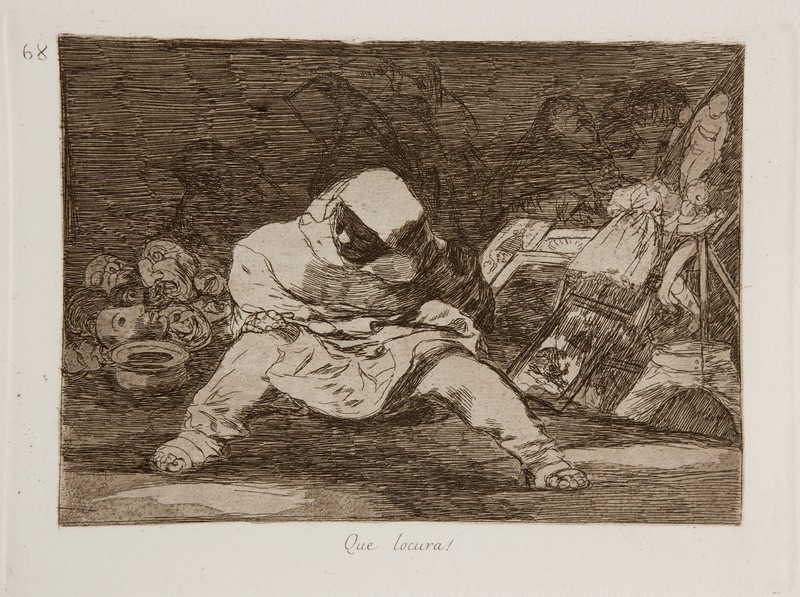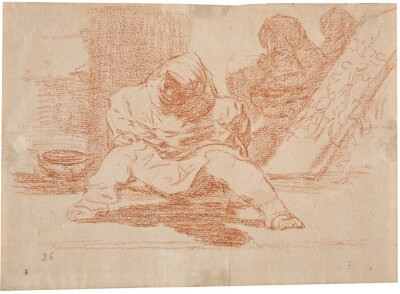- Cronología
- Ca. 1820 - 1823
- Dimensiones
- 160 x 220 mm
- Técnica y soporte
- Etching, lavis and burin
- Reconocimiento de la autoría de Goya
- Undisputed work
- Ficha: realización/revisión
- 22 Dec 2010 / 24 May 2023
- Inventario
- 225
68 (in the top left-hand corner)
See Sad forebodings of what is to come.
In the second state proof, touches of burin can be seen on the monk's left sandal.
The title of the print was handwritten by Goya on the first and only series known to us at the time of its production, which the painter gave to his friend Agustín Ceán Bermúdez. Thus the title was subsequently engraved on the plate without any modification from Ceán Bermúdez's copy for the first edition of the Disasters of War published by the Royal Academy of Fine Arts of San Fernando in Madrid in 1863.
A preparatory drawing is kept in the Prado Museum.
In the foreground, Goya depicts a figure dressed as a friar, holding a plate in his lap and a spoon in his hand. He is surrounded by objects; on the right are sacred images, votive offerings, holy cards, etc., while on the left are a number of masks. In the background, in the darkness, several hooded figures, perhaps other friars like himself, are in procession.
This engraving seems to illustrate the expression "eating the soup" or, in other words, living off the backs of others. The image of the crouching monk serves as a mechanism for Goya to censure certain sectors of the Church which, by manipulating popular devotion, obtained certain economic and material benefits that enabled them to improve their living conditions. In this way, the group of objects with religious content can be related to the masks on the left of the print, as the Aragonese painter is establishing a comparison between the two groups of objects. The sacral objects used by the monk are like the masks with which he characterises himself in order to obtain his own interest.
It is also possible that the painter was aware of the part of Quevedo's text Dreams in which he says: "The faces they had, and they were astonished that they had so many to spare, having lived shamelessly". In What a madness! he was thus referring to the shameless way in which certain members of the clergy lived at the time.
At the same time, in this engraving Goya criticises the proliferation of false healers who promised help or salvation in exchange for a financial reward, as well as the circulation of apocryphal legends. This aspect had also been highlighted by Antonio Bernabeu in his work Spain's Fortunate Spain through the Life of the Constitution and the Death of the Inquisition written in 1820 (National Library of Madrid, R 60.122), which forms part of a current of anticlerical literature that sought to demythologise the Church. In his work Antonio Bernabeu says the following about the usefulness of false healers and the circulation of apocryphal legends: "(...) either to attract offerings with the opinion of miraculous cures, or to preserve acquired goods".
For his part, Jesusa Vega draws a parallel between this print by Goya and what Martínez de la Rosa (Granada, 1787-Madrid, 1862) points out in his work Lo que se puede un empleo (1820): "The strong desire to present in the theatre a certain class of hypocrites who under colour of religion oppose the beneficial reforms among us stimulated me to undertake, as a mere pastime, the composition of this comedy".
What a madness! is the third of the prints in the Emphatic Caprices in which certain religious practices are criticised and in which the retrograde nature of Ferdinand VII's reign is questioned in a hidden way.
The plate is in the National Chalcography (cat. 319).
-
Goya. Das Zeitalter der Revolucionen. Kunst um 1800 (1980 – 1981)Hamburger KunsthalleHamburg1980cat. 94
-
Goya y el espíritu de la IlustraciónMuseo Nacional del PradoMadrid1988from October 6th to December 18th 1988. Exhibited also at Museum of Fine Arts, Boston, January 18th to March 26th 1989; The Metropolitan Museum of Art, Nueva York, May 9th to July 16th 1989, Madrid curator Manuela B. Mena Marqués, scientific directors Alfonso E. Pérez Sánchez and Eleanor A. Sayrecat. 155
-
Francisco Goya. Sein leben im spiegel der graphik. Fuendetodos 1746-1828 Bordeaux. 1746-1996Galerie KornfeldBern1996from November 21st 1996 to January 1997cat. 158
-
Francisco Goya. Capricci, follie e disastri della guerraSan Donato Milanese2000Opere grafiche della Fondazione Antonio Mazzottacat. 148
-
Goya et la modernitéPinacothèque de ParisParís2013from October 11st 2013 to March 16th 2014cat. 107
-
Goya, grabadorMadridBlass S.A.1918cat. 170
-
Goya engravings and lithographs, vol. I y II.OxfordBruno Cassirer1964cat. 188
-
Vie et ouvre de Francisco de GoyaParísOffice du livre1970cat. 1110
-
A solution to the enigma of Goya’s emphatic caprices nº 65-80 of The Disasters of WarApollo1978pp.186-191
-
Goya y el espíritu de la IlustraciónMadridMuseo del Prado1988pp.434-436, cat. 155
-
Catálogo de las estampas de Goya en la Biblioteca NacionalMadridMinisterio de Educación y Cultura, Biblioteca Nacional1996cat. 285
-
Goya en tiempos de guerraMadridMuseo Nacional del Prado2008p.335, fig. 112.1
-
ParísPinacoteca de París2013p. 153
-
Goya. In the Norton Simon MuseumPasadenaNorton Simon Museum2016pp. 114-151

